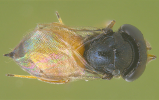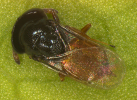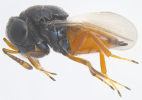 |
Scientific nameCephaleta brunniventris Motschulsky
Taxonomic positionHymenoptera: Chalcidoidea: Pteromalidae
DiagnosisHead and mesosoma shiny black, antenna yellowish brown except scape and apical segment of club darker brown, abdomen yellowish brown with apex darker, legs yellowish brown except all coxae black, tarsi dark brown, first pair of legs slightly darker brown. Head much wider than mesosoma, vertex sharply
angulate behind ocelli, posterior ocellus touching hind margin of vertex. Antennal formula 11143 in female; male antenna nine-segmented, with all funicular segments longer than broad, first one curved and longer than scape. Scrobe slightly concave and only base of scape encased in scrobe. Mesosoma shiny
between punctures. Notaular lines complete. Scutellum with silvery white hairs in apical third. Fore wing pilose.
ImagesDistributionWidely distributed throughout India (Andaman and Nicobar Islands, Andhra Pradesh, Bihar, Delhi, Kerala, Tamil Nadu, Karnataka, Uttar Pradesh, West Bengal). Oriental region. Nearctic.
Hosts / BiologyCommonly collected in association with several species of Coccidae (Sternorrhyncha) including Coccus spp., Ceroplastes spp., Saissetia spp., Drepanococcus chiton, Pulvinaria psidii (Coccidae); Cerococcus indicus (Cerococcidae); Ferrisia virgata
(Pseudococcidae), and Asterolecaniidae.
References
|




